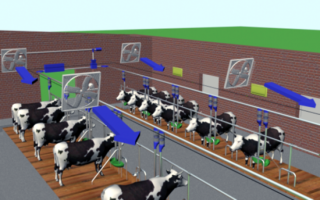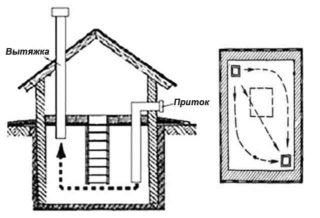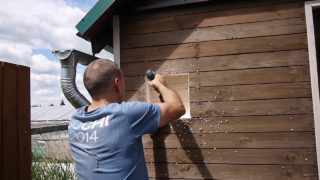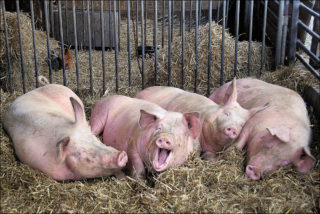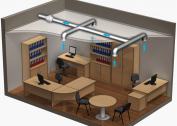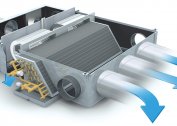A favorable microclimate should be provided not only in residential premises, but also in non-residential ones: attic, garage, cellar or shed. Creating an optimal ventilation system will allow you to achieve the necessary humidity, temperature and oxygen content. You can arrange ventilation in the barn using the recommendations of specialists in the design and selection of suitable materials.
The principle of ventilation
A barn is a room where different things and food can be stored, animals and birds can be kept. A high-quality ventilation system will remove unpleasant odors, remove excess moisture and create favorable conditions for maintenance and storage. Before you make the right extract from the barn, you need to understand its features and the principle of operation.
The basic principle of exhaust systems is to exchange air:
- Air masses enter the supply channel from the street. Fresh cold air is heavier, so it will push the warm exhaust gases up.
- In the upper part, an exhaust channel is created through which stagnant flows are discharged. They are served in small portions and displayed on the street.
Exhaust and supply ducts can be made of metal and plastic pipes with a rectangular or circular cross section. Ventilation can be natural and artificial.
Advantages of natural ventilation:
- A minimum of tools and equipment is required. This affects the efficiency of the system.
- No electricity is required for the operation of fans and hoods.
- Save space.
The disadvantages include the impossibility of adjusting the process and the weakened traction in case of hot climate and calm weather. It also removes bad odors worse.
Advantages of forced ventilation:
- Independence from weather conditions and climate.
- The ability to adjust the process. For this, various automation is installed that measures indicators in real time.
- High intensity of work.
- Qualitative removal of unpleasant odors.
Of the minuses, the need to lay pipes and conduct electricity to the barn is highlighted. All this will entail additional financial expenses. It will also require system maintenance and periodic cleaning of the ventilation ducts.
When choosing an appropriate ventilation system, they are guided by financial capabilities, the availability of space for installing equipment and the available tool. You can make a ventilation system in the barn with your own hands.
Norms of climatic indicators in the barn
In the case of using a barn for keeping animals, it is necessary to maintain climatic norms. The barn should be a fully enclosed room with one entrance and a window. Natural ventilation is through the door and window opening. But it is important to ensure that there is no draft.
Norms when calculating ventilation for a barn:
- The multiplicity of air exchange in the barn with animals and birds is at least 4. You also need to add a margin of 15-20%.
- Temperature conditions depend on the type of animals and birds that are kept indoors. For chickens, the values are 10-15 ° C, for rabbits 9-16 ° C, for pigs 8-15 ° C, for cows 8-25 ° C.
- The humidity level for chickens and rabbits should not exceed 70%, in the barn 50-85%, for piglets up to 80%.
Ventilation should be such that the air does not dry out, the animals are comfortable. The above standards must be strictly observed in large economic complexes. For a household deviations are admissible. How many ventilation openings are placed in the barn depends on the size of the room and the number of livestock.
Typical Shed Design Errors
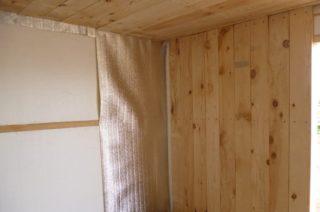
Improper construction and arrangement of the barn can lead to various problems, including cattle disease. There are a number of basic mistakes during construction that can be minimized by the arrangement of ventilation:
- The lack of ventilation holes around the perimeter leads to the formation of mold and fungi.
- The use of cheap low-quality foundation and the lack of insulation. In the absence of thermal insulation and waterproofing, cold and moisture freely penetrate into the room.
- Lack of external waterproofing. This will incur additional heating costs.
These shortcomings adversely affect the climate and humidity level, as well as air exchange. A high-quality ventilation system will help maintain a normal microclimate for the life of animals and birds.
Creating a ventilation system in a room with animals
To organize a suitable microclimate in the barn with animals, the calculation of indicators. The arrangement scheme and the complexity of installation depend on them. The system will include fans, hood.
For chickens
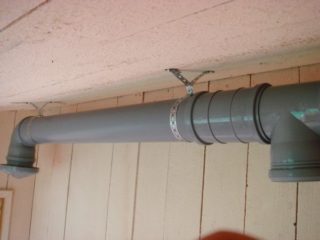
If a small livestock of birds lives in the shed, ventilation is forced or exhausted. It can be done in the shortest possible time without significant costs. Mechanical systems are used for a large number of birds.
Supply and exhaust ducts are carried out using PVC pipes with a diameter of up to 0.2 m and a length of up to 2 m. In the places of perches at the level of 0.3 m from the ceiling, a hole is made for the exhaust pipe. Its height is 1.5-2 meters or more. Where the livestock is the least inhabited, a hole is made for a flow channel at a distance of 0.2 m from the floor. A deflector is placed on the outlet channel to prevent draft.
For pigs
Arranging a shed with pigs requires a more powerful hood due to the large amount of fumes. The layout of the hood:
- At the roof and in the window span are several fans. Their power should be the same in order to avoid drafts.
- To suppress drafts and protect the blades, dividers and gratings are installed. They also protect the ventilation against the entry of debris from the pigsty.
- Plastic and metal pipes are used with a cross-sectional area of at least 62 sq.m. and more than 2 meters long.
- At the bottom and top of the walls, holes are made for air ducts. From the inside, they should be closed with a grill, and pipes will be removed to the outside. Periodically, the grates must be cleaned of jammed debris. Fixing is carried out on metal staples.
- On the input channels put shields to adjust the flow rate.
- A deflector is mounted above the duct to protect against leaves, debris and dirt.
Ducts must be placed vertically. They must be protected against moisture. The pipe on the roof should be insulated if an exhaust channel is made, since condensation will form on its surface due to the temperature difference.
DIY ventilation
Ventilation in the animal shed can be done with your own hands, if the stock is small:
- Creating a system plan with all the necessary calculations. Selection of suitable materials.
- Creation of bastings on the surface for ventilation ducts. Next, make holes of the desired diameter.
- Create holes in front of the fan to drain condensate. They will avoid a short circuit.
- Installation of pipes outside the building with protective umbrellas.
- Lead wiring to the fan, switches, and lighting.
- Electrical connection of all devices.
Thanks to the proper organization of ventilation in the barn, animals and birds will feel comfortable. For small rooms with a small herd, natural or forced ventilation is sufficient. More complex designs will cost more, moreover, they will require more space, and their effectiveness will not be so noticeable.
